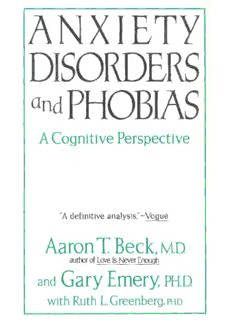
Anxiety disorders and phobias : a cognitive perspective PDF
Preview Anxiety disorders and phobias : a cognitive perspective
ANXIETY DISORDERS and PHOBIAS A Cognitive Perspective Aaron T: Beck, Mp author of Love Is Never Enough and Gary Emery, PHD | with Ruth L.Greenberg, PHD Anxiety Disorders and Phobias By Aaron T. Beck Depression: Causes and Tresiment (1967, 1972) Dingnois and Treatment of Depression (1972) Pradichon of Suicide (1974) (with other editors) Cognition Therapy ad tr Frais! Dasrders (1978) Copnitine Theepy of Beoresson (1979) (with other authors) By Gary Emery Cognitive Theapy of Dereon (1973) {with ather author) New Diratons in Coniie Toray (1981) {vid ther ceitors) A Nap Beginning (1981) un Your Oum Life (1988) Rapid Rolf Foo Prvional Disiess (1985) (ith Janses Campbell) ANXIETY DISORDERS AND PHOBIAS A Cognitive Perspective Aaron T. Beck and Gary Emery with Ruth L. Greenberg Litracy of Cangra Catalog ta Publication Data Sok, Aaron T. Saraiety disirders ond phobins Reterences: Jz Include inde 1 Aswily. 2 Whoblas. 3. Cognitive therapy _Eovery, Gary, Il Greenberg, Ruth LW) Tile [DNLM "1. Anslety Disowters 2. Behavior Therapy 3, Coyntin, A. Publ Diauider, WOE 172. 69934] Ressiki is steas22y 84 a2et? ISBN q-das-00324 2. (loti) ISHN O-485-00225-0 [paper CCopyelahe © 1995 by Aaron T. Beck, MIP, and Gary Emery. OO. Pana tte United Slater of America Designed by Vincent Tene 95 96 97 98 99 MC 16 15 14 Contents Prefwe xv PART I Theoretical anid Clinica! Aspects BY AARON T. BECK Chapter 1 Turning Anziety on its Head: An Overview 3 The Paradox of Anxiety Changing Concepts of Amxiety Distinguishing Anxiety, Fear, Phobias, and Panic Future Danger and resent Danger The Function of Anxiety Survival Mechanisms Chapter 2 Sypplons: aid Their Sigsifeance ty Systems and Symptoms FErE-noATING OE —HACT OH AENIACTE Thinking Disorder in Clinical Anxiety vi Contents 1088 oF ourtenezre AND OF YoUINTARY CONTROL Classification of Anxiety Disorders Chapter 3 The Cognitive Met of Tireat Resehons ” The Role of Context ‘The Nature of Cognitive Processing Primal Responses to Threat Chapter 4 Copistve Struchures and Ansiggevic Redes 54 Cognitive Schemas ‘The Modes Contents vii Chapter 5 Valherabiltys The Core of Amtiely Disasters or ‘The Concept of Vulnerability The “Function” of Dysfunctional Behaviors The Domains of Vulnerability Chapter € Genetatized Anxiely Disorder and Panie Disorder 82 Tnedence General View of the Etiology of Anxiety Disorders 16 cocRiIONS CAUBe ANNIETY DISORDERS? Genwralired Anxiety Disorder Panic Disorder Chapter 7 Sirple Phobivs us Definition of Phobia Contents Classification The Meanings of Phobias Relation of Fears 1o Phobias Evolution, Rules, and Phobias Chapter 8 The Agoraphobie Syndrome 133 The Riddle of Agoraphobia The Development of Agoraphobia Panic Dependency A Synthesis Chapter 9 The Eraluation Arzietce 146 ‘The Fagence of Evaluation Anxieties Common Features of Evaluative Threats Social Phobias and Social Activines Paradoxes of Social Anxiety Differentiating Social Phobia from Agoraphobia The Phenomena of Sucial Anxiety Contenis ix A Synthesis PART II Caguitive Therapy: Techniques and Applications BY GARY EMERY Chapter 10 Principles of Cognitive Therapy 187 Principle 1: Cognitive Therapy Is Bared on the Cogninve Model of Emotional Disorders Principle 2: Cognitive Therapy Is Brief and Time-Limited Principle 3 A Sound Therapeutic Relationship Is a Necessary Condition for Effective Cognitive Thecapy Vrineiple 4: Therapy Is a Collaborative Effort Between Therapist and Patient Principle 5: Cognitive Therapy Uses Primasily the Secratic ‘Method Mrinciple 6: Cognitive Therapy Is Structured and Directive Principle 7: Cognitive Therapy Is Froblem-Oriented Principle 8: Cognitive Therapy Is Based on an Educational Model Principle 9: The Theory and Techniques of Cognitive Therapy Rely ov the Inductive Method Principle 10: Homework Js a Central Feature of Cognitive ‘Therapy Chapter 11 Steatgies and Techniques for Cognitive Restructuring 190 Developing Self- Awareness Strategies and Techniques
